In the bustling landscape of modern marketing, where every second counts and every impression matters, transit marketing emerges as a dynamic and impactful strategy. Transit advertising offers a unique canvas for creativity, blending the physical and digital worlds to engage a diverse audience. With the right approach, transit ads can become more than just messages on a wall or a bus; they can become integral parts of the urban experience, making everyday commutes a little more exciting and engaging.
This blog explores the next stop in the journey of transit advertising by delving into creative ideas that can captivate and engage audiences on the move.
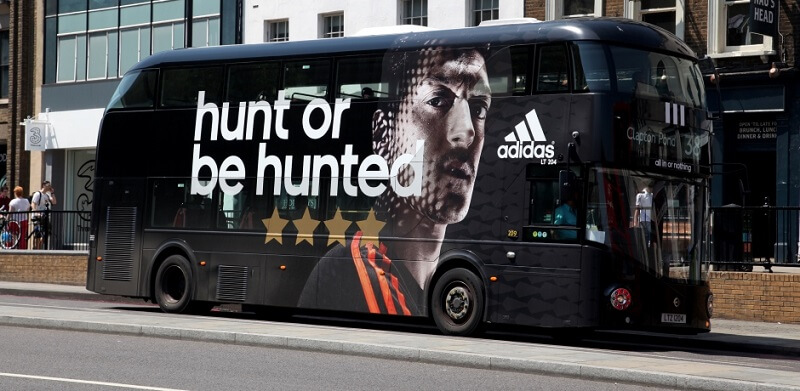
The Power of Transit Advertising
Transit advertising is a powerful way to reach a large and diverse audience. It has evolved beyond simple posters and banners. It now encompasses a range of formats including bus wraps, subway car takeovers, digital displays, and even interactive installations. The key to successful transit advertising lies in its ability to blend seamlessly with the environment while standing out enough to capture attention. Commuters spend significant time in transit, making them an ideal target for engaging and memorable advertisements. Moreover, transit systems serve a diverse demographic, enabling brands to reach a wide range of target audiences.
How to Create an Effective Transit Ad
- Understanding the Commuter Demographic
Before diving into creative concepts, it’s crucial to understand the diverse demographic that uses public transportation. This audience includes professionals, students, tourists, and everyday city residents. They are often in a state of transition, moving from one place to another, which means that ads need to be quick to grasp and compelling enough to hold attention. The challenge is to create designs that resonate with this varied demographic while being clear and concise.
- Choose the Right Format
Transit advertising comes in various formats, including bus wraps, train ads, subway posters, and taxi ads. Each format offers unique opportunities and challenges:
Bus Ads: From eye-catching bus wraps to interior posters, buses offer ample space for creative messaging that captures the attention of both pedestrians and drivers.
Train Ads/Subway Ads: With ads displayed inside train cars, on station platforms, and along subway corridors, transit riders are exposed to messaging at multiple touchpoints throughout their journey.
Transit Shelter Ads: Located along busy streets and near public transportation stops, bus shelters provide prime advertising space. Posters, digital screens, and interactive displays at bus shelters can capture the attention of pedestrians and waiting commuters.
Taxi Ads: Taxis offer a mobile platform for advertising, with wraps covering the vehicle’s exterior. These wraps can feature vibrant designs and brand messaging, effectively reaching pedestrians and other motorists as the taxi navigates urban streets.
- Keep It Simple and Clear
Simplicity is crucial in transit advertising. Commuters have limited time to absorb information, so your message should be clear and concise. Avoid cluttering the ad with too much text or overly complex graphics. Focus on a single, strong message with a clear call-to-action (CTA).
- Ensure Strong Branding
Consistent branding helps reinforce your identity and ensures recognition. Incorporate your logo, brand colors, and fonts consistently across all transit ads. Strong branding in transit ads builds familiarity and trust, making it easier for commuters to remember and associate the ad with your brand. Ensure that your branding elements are prominently displayed and easy to recognize.
- Make It Relevant
Ads that resonate with the daily experiences and needs of commuters are more likely to be effective. Tailoring your message to the specific context of the transit environment can increase its impact. For instance, promoting a coffee brand with an ad that highlights the convenience of grabbing a coffee on the way to work. Understanding the demographics and behaviors of the transit audience allows for more targeted and relevant advertising.
- Incorporate Interactive Elements
Interactive elements can significantly enhance engagement with transit ads. QR codes, augmented reality (AR), and other digital interfaces encourage commuters to interact with the ad beyond a fleeting glance. For example, a QR code might lead to a special promotion, a contest, or additional content. These interactive features create a deeper connection with the audience and can increase the overall impact of the ad.
- Be Creative
Creativity helps your ad stand out and be memorable. Think outside the box and use innovative concepts to capture attention. Unique designs, humor, storytelling, and clever use of space can make your ad more engaging. For example, an ad that turns a bus into a giant moving aquarium or uses humor to catch attention can be highly effective.
- Utilize Unique Spaces
Transit environments offer unique advertising spaces that can be creatively utilized. Staircases, turnstiles, ceilings, and even floors can become advertising canvases. These unconventional placements can increase visibility and engagement.
- Monitor and Adapt
Finally, it’s essential to monitor the effectiveness of your transit ad campaign and make necessary adjustments. Track engagement metrics such as reach, interaction rates, and conversion rates. Gather feedback from your audience to understand what worked and what didn’t. Use this data to refine your strategy and improve future campaigns.
Ways to Captivate the Audience
- Immersive Experience
One of the most effective ways to captivate transit audiences is through immersive experiences. These ads go beyond traditional 2D visuals and engage multiple senses. For instance, a bus shelter could be transformed into a mini-experience center for a travel agency, complete with sounds and scents of exotic destinations. Similarly, a subway car could be redesigned to mimic the interior of a cozy café, promoting a coffee brand. By creating an environment that envelops the commuter, brands can leave a lasting impression.
Nintendo – “Switch Where You Play”
Nintendo’s transformation of a NYC subway car into a life-sized Nintendo Switch console exemplified the power of immersive and experiential marketing. By integrating the gaming world into a daily routine, Nintendo not only captured the attention of commuters but also created a memorable brand experience that resonated deeply with its audience. This campaign successfully extended the reach of the Nintendo Switch brand and showcased the potential of innovative transit advertising to engage and delight consumers.
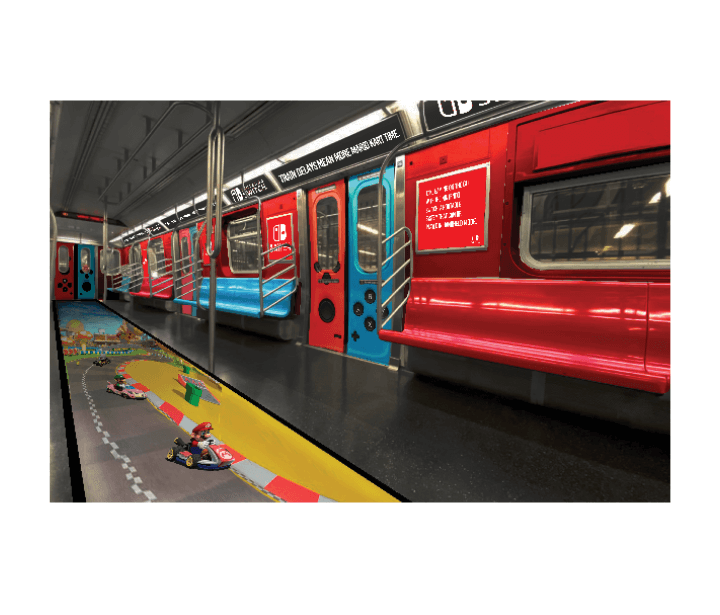
2. Interactive Ads
Interactive ads invite engagement, transforming passive viewers into active participants. In the digital age, incorporating technology into transit ads can significantly enhance engagement. Digital screens with touch capabilities or motion sensors can provide interactive experiences that entertain and inform.
BC Hydro – “Motion Sensor”
To encourage British Columbians to adopt power-saving behaviors, BC Hydro launched an innovative transit campaign that conserved electricity through the ad itself. By installing motion sensors in backlit transit shelters, the lights only turned on when someone was present, saving over 100 Kwh of electricity. This creative execution demonstrated the ease of energy conservation and contributed to a broader multimedia campaign that led to 84,000 additional households adopting energy-efficient practices, with 91% of British Columbians now practicing energy-conscious behaviors in their homes.
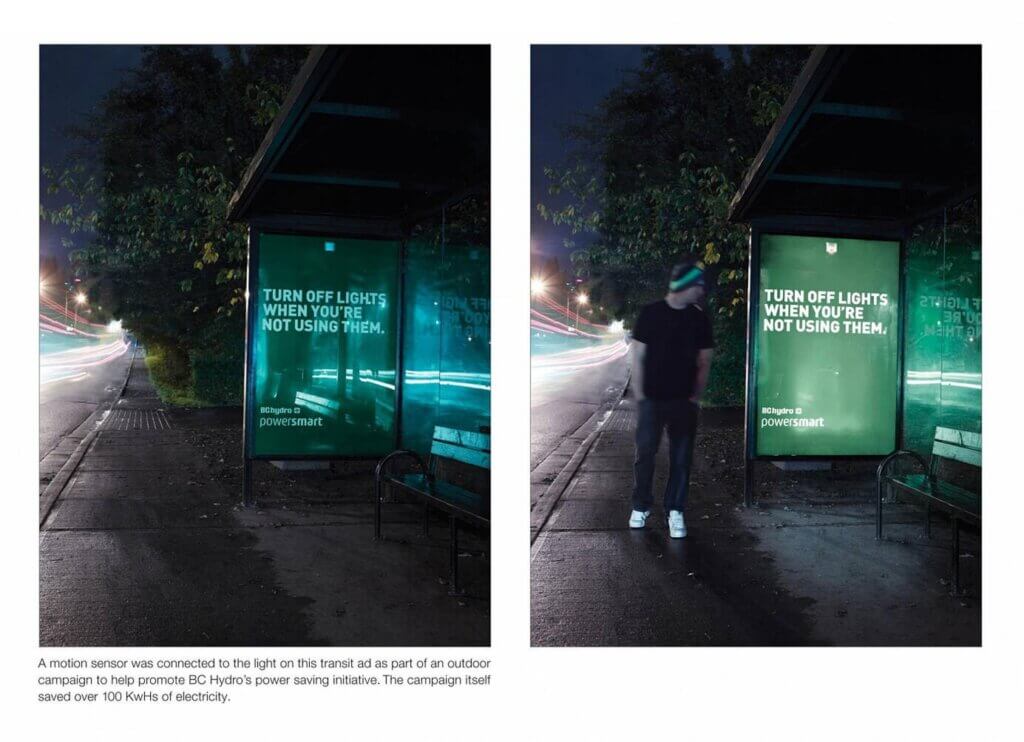
3. Humor and Playfulness
Humor is a universal language that can break the monotony of a commuter’s journey. Funny and playful ads can make people smile and create positive associations with the brand.
International Spy Museum – “The Capital of Spycraft”
The International Spy Museum, known for its vast collection of espionage artifacts like James Bond’s Aston Martin and the Trotsky Ice Axe, as well as interactive exhibits, sought to boost bookings for 2022 by showcasing its unique, immersive experiences. To stand out among DC attractions, the campaign emphasized that visitors don’t just visit the museum—they live it. The strategy included taking over subways, wrapping buses, and extensive digital advertising, targeting tourists and locals by highlighting the museum’s interactivity and the thrill of espionage. By using data-driven ad placements and compelling narratives about the spy experience, the campaign achieved a 31% year-over-year increase in ticket sales, resulting in the highest return on ad spend (ROAS) the museum has ever seen as of spring 2023.
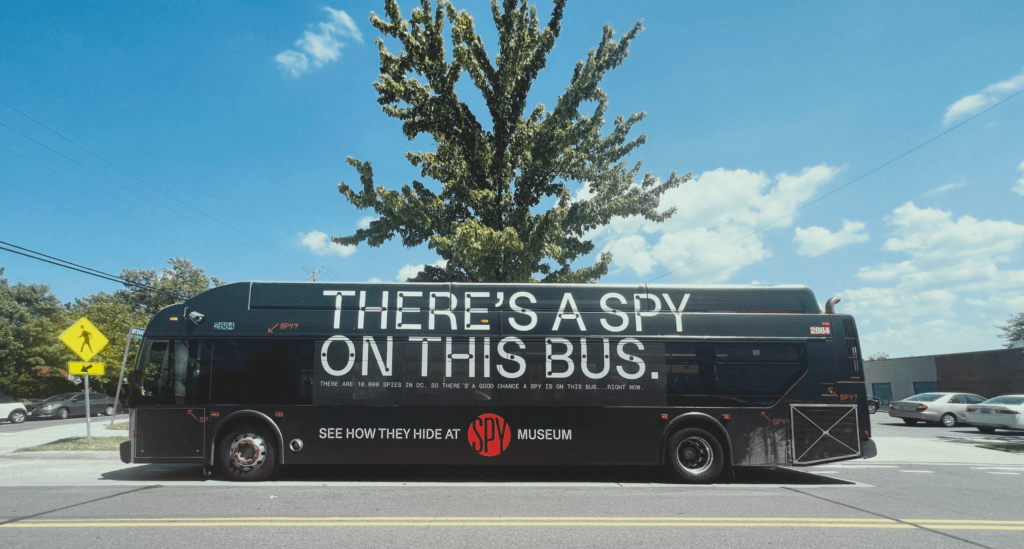
4. Engaging bus shelters
Engaging bus shelters are not just places to wait for the next ride; they are immersive experiences that captivate and delight commuters. These shelters go beyond traditional advertising by transforming into interactive spaces that engage multiple senses and create memorable moments. This innovative approach not only promotes the brand but also provides commuters with a unique and enjoyable experience during their daily commute. With engaging bus shelters, waiting for the bus becomes a delightful experience, leaving a lasting impression on commuters and fostering a positive brand association.
Caribou Coffee – “Ovens out of transit shelters”
Caribou Coffee introduced their new hot breakfast sandwiches in a uniquely cozy manner that resonated with Minnesotans braving the winter chill. They transformed transit shelters into functioning ovens, complete with real heat, to emphasize the warmth and deliciousness of the new menu items. This innovative approach not only highlighted the hot breakfast options but also provided commuters with a welcome respite from the cold, making the campaign both practical and memorable. This creative strategy not only drove home the message of hot, tasty breakfasts but also fostered a positive brand association among cold-weather commuters.
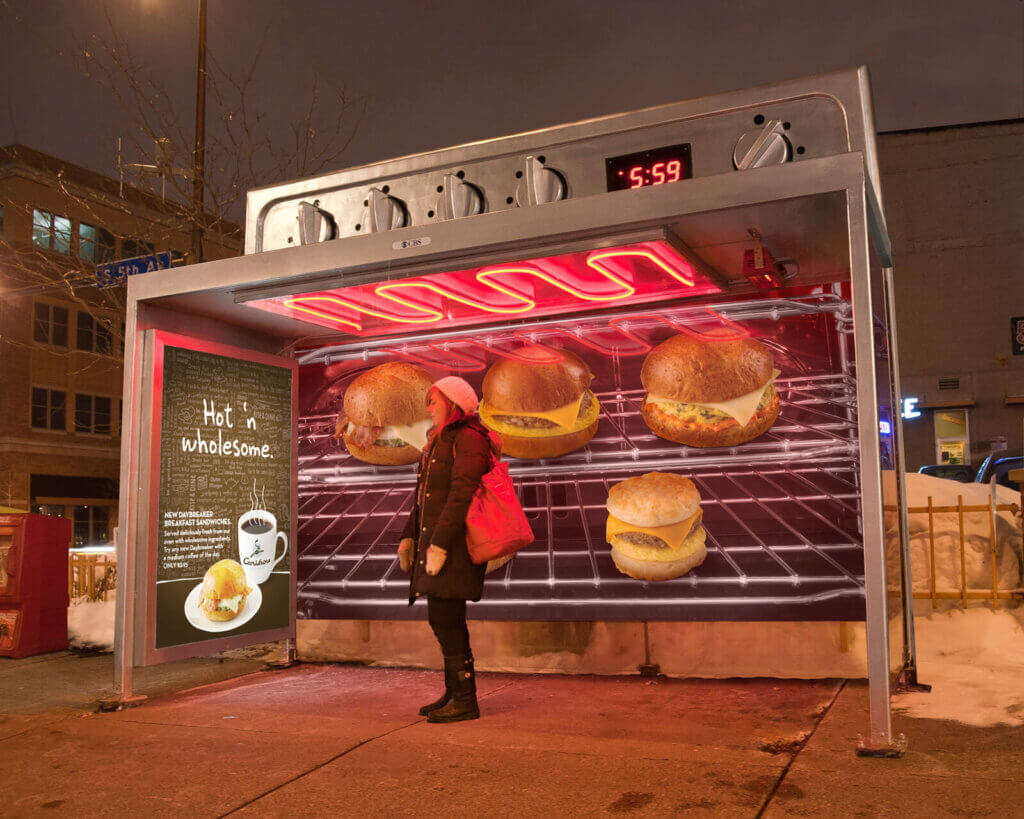
5. Smart and Responsive Ads
Smart and responsive ads represent the cutting edge of transit advertising by using technology to create dynamic, context-aware experiences. These ads can change in real-time based on environmental conditions, audience demographics, or specific triggers. For instance, an ad equipped with sensors might display different messages based on the weather, promoting hot coffee on a cold day and iced coffee when it’s hot. These adaptive ads not only capture attention but also provide relevant and timely information, enhancing the overall effectiveness of the campaign.
KLM – “The Refund Billboard”
An intriguing example of smart and responsive transit ads is KLM’s interactive billboard in Sweden. This ad cleverly detects cold symptoms such as coughing and sneezing, using a listening device and an AI engine capable of identifying 40,000 different sounds. When a symptom is detected, the general travel billboard showcasing a lovely surf destination at a low price switches to a more relevant message, such as “Unwell?” or “Bless you!” followed by “Cancel Lisbon €0”. This innovative approach not only catches the attention of commuters but also provides useful and timely information, highlighting KLM’s flexible booking options.
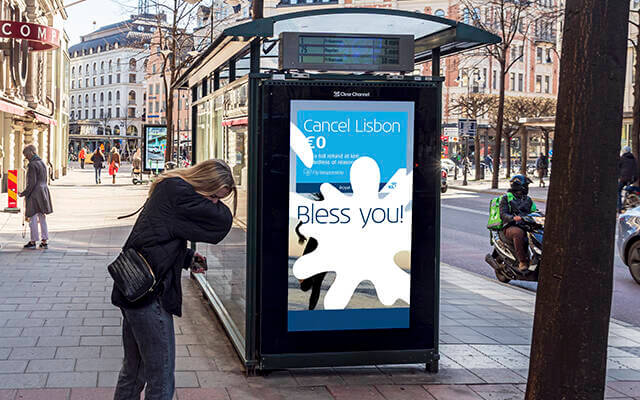
6. Interactive QR Codes
By strategically placing QR codes on posters, bus stops, and inside transit vehicles, brands invite commuters to scan and unlock additional content, participate in challenges, or enter contests. These campaigns transform advertisements into interactive journeys, offering personalized information, mini-games, or exclusive rewards. This interactive approach not only captures the attention of tech-savvy commuters but also encourages ongoing engagement and interaction with the brand, making the daily commute an entertaining and memorable part of the day.
SF Bio – “The QR Code Treasure Hunt”
SF Bio, the largest chain of movie theaters in Sweden, devised an innovative campaign to make this summer unforgettable for one lucky movie fan. They offered a “Movie Summer Package” prize, granting the winner unlimited free admission to all SF movie theaters across Sweden for the entire summer. The headline cryptically stated, “There is a complete Movie Summer hidden in these headlines. Find the right code and it could be yours. Det var Grattis!” The headline was constructed from 687 QR codes, with 686 leading to a “Try again” message and one elusive code directing to a mobile site where participants could enter their name to win. This interactive approach not only engaged moviegoers but also created a buzz around SF Bio, enhancing brand visibility and customer interaction.
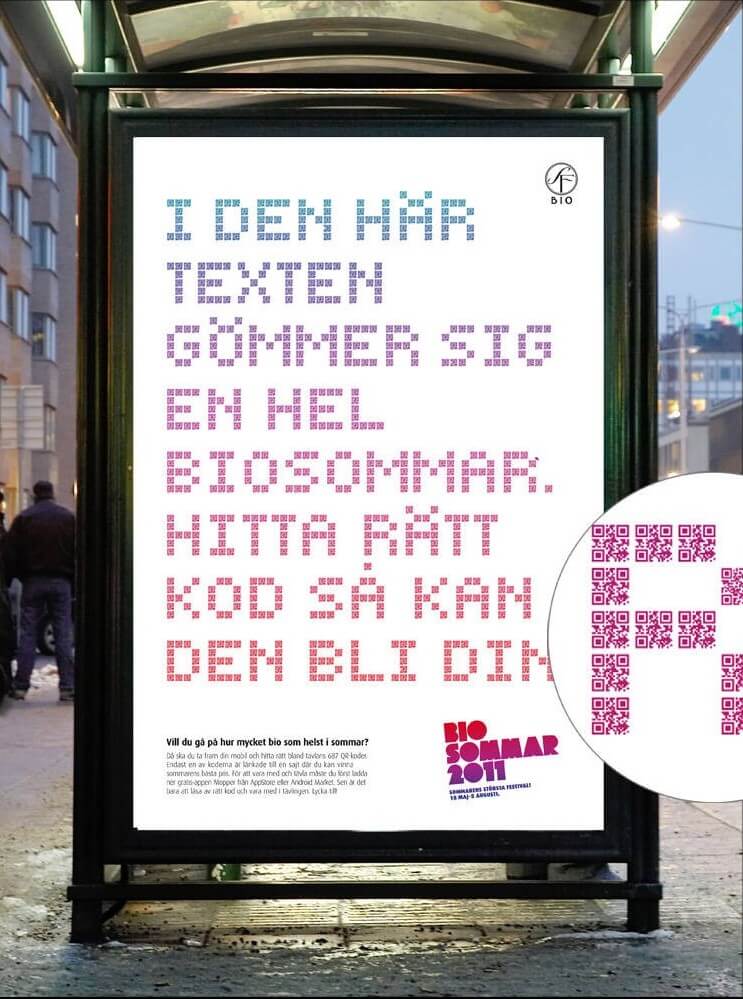
Conclusion
Transit advertising offers a unique canvas for creativity, blending the physical and digital worlds to engage a diverse audience. Creating an effective transit ad requires a blend of strategic thinking, creative design, and a deep understanding of your audience. By thinking beyond traditional ads and incorporating elements of interactivity, technology, and environmental design, brands can create memorable experiences that resonate with commuters.
As cities continue to grow and evolve, so too will the opportunities for transit advertising. The next stop in this journey promises to be filled with innovation, creativity, and endless potential for brands willing to think outside the box. With the right approach, transit ads can become more than just messages on a wall or a bus; they can become integral parts of the urban experience, making everyday commutes a little more exciting and engaging.


